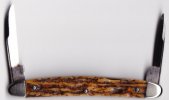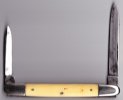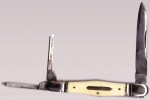- Joined
- Dec 7, 2007
- Messages
- 350
Can't imagine the man hours that went into all the carving and file work to the blade spines and liners. I wonder what such a knife cost when it was made and the price relative to today.
Joe
Thanks for the additional comments on the "Nautilus" & Parkin & Marshall Jeremy, Joe and Charlie :thumbup:.
Joe, I think labour was much cheaper, back in the 19th century, materials were a much greater part of the manufacturing cost back then. Very difficult to do a then and now price comparison.
Here's a very "plain" looking quill knife, sort of the opposite in style to the previous two, just as good a quality though, as it's so wonderfully made, marked MECHI, SPECIAL STEEL, 3 1/4", made C1827-59, brass liners, threaded and spoon ended nickel silver bolsters, looks unused, highly likely made in Sheffield.
John Joseph Mechi was a London cutler based at No4 Leadenhall Street, London, he exhibited at the 1851 Great Exhibition, he sold a range of top quality items.



Thanks for looking ..Mick




























